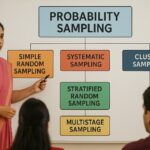Selecting the right variables is a crucial step in designing a research study. The choice of variables determines the quality of data collected, the effectiveness of analysis, and the overall validity of research findings. Whether conducting quantitative, qualitative, or mixed-methods research, carefully identifying variables ensures that the study achieves its objectives.
In this blog, we explore how to select the right variables for your research, the different types of variables, and key factors to consider when making your selection.
1. What are Research Variables?
Variables are measurable characteristics or attributes that can change or vary across individuals, groups, or situations. In research, variables help define the relationships between different factors and form the foundation of hypothesis testing.
Example: In a study on customer loyalty in retail stores, possible variables include customer satisfaction, promotional programs, and shopping experience.
2. Types of Variables in Research
To select the right variables, it is essential to understand their different types:
a) Independent and Dependent Variables
Independent Variable (IV) – The factor that is manipulated or categorized to observe its effect on another variable.
Dependent Variable (DV) – The outcome or effect that is measured in response to changes in the independent variable.
Example:
In a study examining the effect of Green Banking Adoption on Customer Engagement,
- Green Banking Adoption (IV) influences
- Customer Engagement (DV)
b) Control and Extraneous Variables
Control Variables – Factors that are kept constant to prevent them from affecting the dependent variable.
Extraneous Variables – Uncontrolled factors that may interfere with the study results.
Example: If studying the impact of advertising strategies on brand awareness, variables like income level, education, and prior exposure to advertisements should be controlled.
c) Moderator and Mediator Variables
Moderator Variable – Affects the strength or direction of the relationship between IV and DV.
Mediator Variable – Explains how or why an independent variable influences a dependent variable.
Example:
In a study on employee training (IV) and job performance (DV):
- Job Satisfaction may act as a mediator (explains the relationship).
- Work Experience may act as a moderator (strengthens or weakens the relationship).
3. Steps in selection of right Variables in Research
This section explores three key steps to selecting the right variables, along with practical examples.
Step 1: Define your Research Objectives and Questions
The first and most important step in selecting variables is to clearly define your research objectives and questions. Your variables should align with the purpose of the study and directly contribute to answering your research questions.
How to do it?
- Identify the main concept of your study.
- Determine what you want to measure, analyze, or predict.
- Formulate clear and specific research questions that guide variable selection.
Practical Example: Green Banking Adoption
Research Objective:
“To examine the factors influencing Green Banking Adoption and their impact on customer engagement and satisfaction.”
Research Questions:
- What factors influence a customer’s decision to adopt green banking?
- How does perceived usefulness affect green banking adoption?
- What is the relationship between green banking adoption and customer satisfaction?
Variables Identified:
- Independent Variables (IV): Perceived usefulness, environmental awareness, green trust
- Dependent Variables (DV): Green banking adoption, customer satisfaction
In this case, each selected variable directly contributes to answering the research questions.
By defining the research objectives and questions first, you ensure that your variables are relevant, focused, and aligned with your study’s goals.
Step 2: Review Existing Literature to Identify Key Variables
The next step is to examine past research and identify commonly used variables related to your topic. Reviewing literature helps:
- Validate that your variables are relevant and tested in prior studies.
- Avoid selecting unnecessary or redundant variables.
- Identify moderator or mediator variables that can strengthen your study.
How to do it?
- Look for recent journal articles, dissertations, and industry reports on your topic.
- Identify commonly used variables in similar studies.
- Check if previous studies found strong correlations between these variables.
Practical Example: Socially Responsible Investing (SRI) and Reinvestment Intention
Existing Research Findings:
- Previous studies suggest that corporate reputation, environmental sustainability, and return on investment (ROI) influence socially responsible investing decisions.
- Investors tend to reinvest in ESG companies when they perceive strong governance and ethical business practices.
Selected Variables:
- Independent Variables (IV): Corporate reputation, sustainability perception, ROI
- Moderator Variable: Trust in ESG companies (strengthens the relationship between IV and DV)
- Dependent Variable (DV): Reinvestment intention
Here, literature review supports the selection of key variables, ensuring that the study builds on established knowledge rather than selecting arbitrary factors.
Step 3: Ensure Measurability and Data Availability
Even if a variable appears relevant, it must be measurable to be useful in research. A well-chosen variable should be:
- Quantifiable – Can it be measured numerically?
- Observable – Can you collect real-world data for it?
- Practical – Is the data easily accessible?
How to do it?
- Choose variables with defined measurement scales (e.g., Likert scales, percentages, ratings).
- Ensure that data collection is feasible through surveys, secondary data, or experiments.
- Avoid abstract or vague variables that are difficult to define.
Practical Example: Measuring Customer Satisfaction in Physical Retail Stores
Instead of using “customer happiness” (a vague concept), a measurable variable would be:
“Customer satisfaction score” – Measured on a 5-point Likert scale (Strongly Disagree to Strongly Agree).
“Repeat Purchase Behaviour” – Number of purchases made within six months.
Final Variable Selection:
- Dependent Variable (DV): Customer satisfaction (measured via Likert scale)
- Independent Variables (IV): In-store experience, promotional programs, customer service
By ensuring that variables are measurable and backed by available data, researchers can perform accurate statistical analysis and draw meaningful conclusions.
Final Thoughts
Selecting the right variables is essential for credible and impactful research. By following these three key steps:
Step 1: Define research objectives and questions – Ensure variables align with the study’s goals.
Step 2: Review existing literature – Validate variables based on previous research.
Step 3: Ensure measurability and data availability – Choose variables that can be quantified and practically collected.
By applying these steps in your research, you can avoid errors, strengthen your study, and produce reliable findings.
Would you like help in selecting variables for your specific research? Let me know!









Leave a Reply